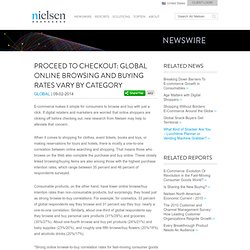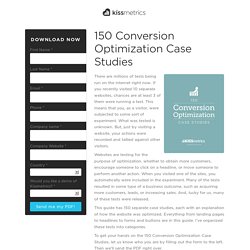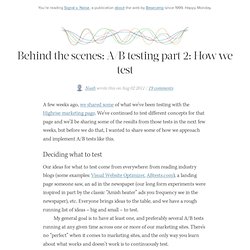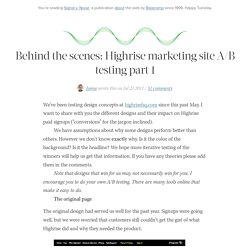

Proceed to Checkout: Global Online Browsing and Buying Rates Vary by Category. E-commerce makes it simple for consumers to browse and buy with just a click.

If digital retailers and marketers are worried that online shoppers are clicking off before checking out, new research from Nielsen may help to alleviate that concern. When it comes to shopping for clothes, event tickets, books and toys, or making reservations for tours and hotels, there is mostly a one-to-one correlation between online searching and shopping. That means those who browse on the Web also complete the purchase and buy online. These closely linked browsing/buying items are also among those with the highest purchase intention rates, which range between 35 percent and 46 percent of respondents surveyed. Consumable products, on the other hand, have lower online browse/buy intention rates than non-consumable products, but surprisingly, they boast just as strong browse-to-buy correlations. Resources & Blog - @RedEyeUK. Blog - A/B Split Testing Ideas and Conversion Optimization Tips. So you run a test or two, have your moments of virtual euphoria and promise yourself to roll out a meticulous Conversion Rate Optimization (CRO) strategy to increase website sales and revenue.

But then… You lose steam, the inspiration wears off, you don’t have the time or the mental bandwidth to conduct the research this “long and winding” process requires. You want quick, Flash-like results, so you give into the delicious temptation of running more random tests. A successful random test, after all, is like a seductress. The northward-looking graphs, that beautiful-almost-perfect statistical significance, the simple awareness that a mere tweak can bring in so much more fortune. 150 Conversion Optimization Case Studies. There are millions of tests being run on the internet right now.

If you recently visited 10 separate websites, chances are at least 3 of them were running a test. This means that you, as a visitor, were subjected to some sort of experiment. What was tested is unknown. But, just by visiting a website, your actions were recorded and tallied against other visitors. Websites are testing for the purpose of optimization, whether to obtain more customers, encourage someone to click on a headline, or move someone to perform another action. 150 Conversion Optimization Case Studies by Dmitriy Podluzny. Conversion Rate Optimization Report 2013. InShare00inShare Downloads SAMPLE: Conversion Rate Optimization Report 2013 (1.47 MB PDF) Conversion Rate Optimization Report 2013 (3.67 MB PDF) Presentation: Conversion Rate Optimization 2013 (925 KB PDF) Conversion Rate Optimization Report Data (73.6 KB Microsoft Excel) This is the fifth annual Econsultancy Conversion Rate Optimization Report, in association with RedEye.

The research looks at the types of conversion and measurement used, as well as the tools, strategies and processes employed for improving conversion rates. The report also examines different areas of best practice and identifies which techniques and methods are most valuable for improving conversion rates. The aim is to provide data and a framework to help companies invest their time and resources as effectively as possible, by examining which methods and processes are most likely to yield results. A 27-slide presentation detailing the key findings is also available for download. Report highlights include: Table of contents. Behind the scenes: A/B testing part 2: How we test by Noah of Basecamp. A few weeks ago, we shared some of what we’ve been testing with the Highrise marketing page.

We’ve continued to test different concepts for that page and we’ll be sharing some of the results from those tests in the next few weeks, but before we do that, I wanted to share some of how we approach and implement A/B tests like this. Deciding what to test Our ideas for what to test come from everywhere: from reading industry blogs (some examples: Visual Website Optimizer, ABtests.com), a landing page someone saw, an ad in the newspaper (our long form experiments were inspired in part by the classic “Amish heater” ads you frequency see in the newspaper), etc. Everyone brings ideas to the table, and we have a rough running list of ideas – big and small – to test.
My general goal is to have at least one, and preferably several A/B tests running at any given time across one or more of our marketing sites. Implementing the tests Evaluating the results. Behind the scenes: A/B testing part 3: Finalé by Jamie of Basecamp. I was an A/B test skeptic.

Maybe we don’t want to be second-guessed. Maybe we don’t want to cater to the lowest common denominator. Designers are taught—explicitly and implicitly—to follow certain visual rules and the final design will work great. The whole A/B testing concept probably came from from “strategy analysts” or “MBAsses”. Anyway, now I’m a believer in A/B testing. How I Learned to Stop Worrying and Love the Bomb Designers, you’ve been in critiques where Clients, Art Directors, Creative Directors, Project Managers, Copywriters, Executive Assistants, and other Designers have picked apart your work. Next time say, “I hear your concern about the shade of red. Behind the scenes: Highrise marketing site A/B testing part 1 by Jamie of Basecamp. We’ve been testing design concepts at highrisehq.com since this past May.

I want to share with you the different designs and their impact on Highrise paid signups (“conversions” for the jargon inclined). We have assumptions about why some designs perform better than others. However we don’t know exactly why. Is it the color of the background? Is it the headline? Note that designs that win for us may not necessarily win for you. The original page The original design had served us well for the past year.